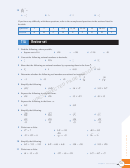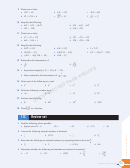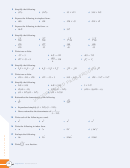Surds And Indices Page 6
ADVERTISEMENT
6
Convert the following recurring decimals to fractions.
.
.
.
.
.
.
.
.
.
.
a
b
c
d
e
0.
4
6
0.
9
1
0.
3
0
0.
6
3
0.
9
8
7
Convert the following recurring decimals to fractions.
Hint: Before subtracting
.
.
.
.
.
.
a
b
c
multiply by 1000.
0.
58
6
0.
23
9
0.
85
2
.
.
.
.
d
e
0.
42
3
0.
61
5
EXAMPLE 5
Convert the following recurring decimals to fractions.
Make the decimal parts the
.
.
a
b
same before subtraction.
0.3
5
0.51
2
.
.
Let n = 0.3
Let n = 0.51
a
b
5.
2
n = 0.35555 …
n = 0.512222 …
10n = 3.5555 …
100n = 51.2222 …
Then
Then
100n = 35.5555 …
1000n = 512.2222 …
and
and
By subtraction, 90n = 32
By subtraction, 900n = 461
32 ___
16 ___
461
____
n =
=
n =
Hence
Hence
90
45
900
.
.
16
461
∴ 0.3
5 =
__
∴ 0.51
2 =
___
45
900
8
Convert the following recurring decimals to fractions.
.
.
.
.
.
a
b
c
d
e
0.3
8
0.6
5
0.9
2
0.1
6
0.0
9
9
Convert the following recurring decimals to fractions.
.
.
.
.
.
a
b
c
d
e
0.54
6
0.72
3
0.76
2
0.90
5
0.04
9
In general:
Step 1: Let n equal the recurring decimal.
Step 2: Multiply n by the positive power of the decimal place before the fi rst repeating digit.
Step 3: Multiply n by the positive power of the decimal place of the last repeating digit.
Step 4: Subtract Step 2 from Step 3.
Step 5: Solve for n as a fraction.
10
Convert the following recurring decimals to fractions, using the multiples of n given.
.
.
.
.
a
b
0.0
5
7 (10n and 1000n)
0.30
4
5 (100n and 10 000n)
.
.
.
.
c
d
0.
220
5 (n and 10 000n)
0.1
27
5 (10n and 10 000n)
Real number system
C
Real numbers are those that can be represented by points on a number line. Real numbers are either rational
or irrational.
• A rational number is a real number that can be expressed
Think: rational means 'ratio-nal'.
a __
of two integers, where b ≠ 0.
as the ratio
b
• An irrational number is a real number that is not rational.
6
Insight Maths 9
Australian Curriculum
ADVERTISEMENT
0 votes
Related Articles
Related forms
Related Categories
Parent category: Education
 1
1 2
2 3
3 4
4 5
5 6
6 7
7 8
8 9
9 10
10 11
11 12
12 13
13 14
14 15
15 16
16 17
17 18
18 19
19 20
20 21
21 22
22 23
23 24
24 25
25 26
26 27
27 28
28








